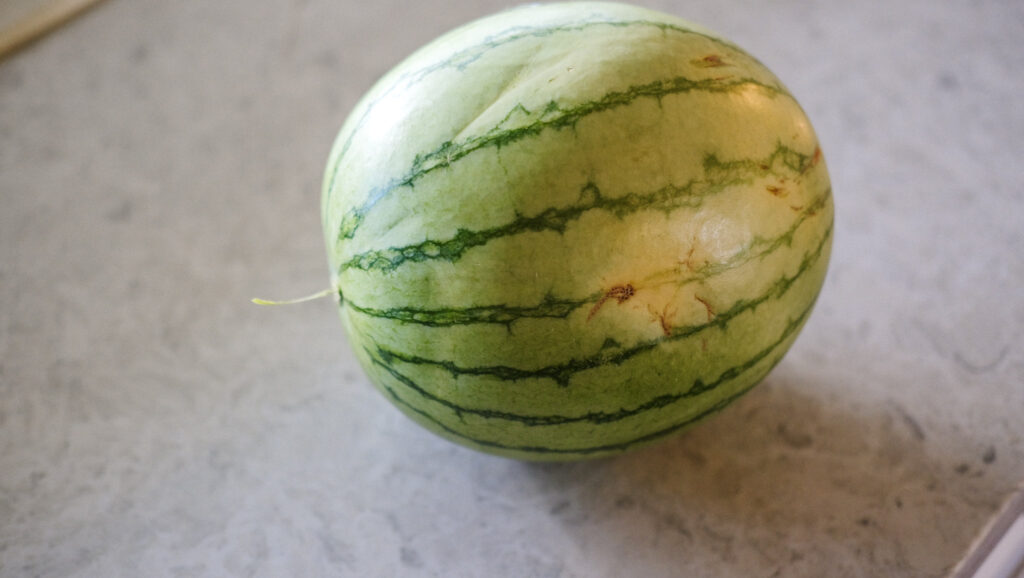September 2, 2025
Welcome to the Daily Dolce! The month of September, I’ll be doing a daily challenge to study a little bit of Italian every day and post about it here on Savor & Speak. My goal is to actually remember what I learn by writing about it, and I hope if you stumble upon this post that it might inspire you to join me (whether you are an English speaker learning Italian…or an Italian speaker learning English!).
The goal of this series is to get back into a consistent Italian learning routine, piano, piano – even if it’s just a word a day. I have no plan of what I’ll learn. I’m just letting whatever pops up in daily life be my inspiration because there’s no better context than daily life. Experiences make language memorable.
So here we go! Even though it’s 11 p.m…and I’m racing the clock before it’s midnight. Always a night owl!
Daily Dolce #1: How to pick out a ripe watermelon
Today’s Italian vocabulary is inspired by how to pick out a ripe watermelon. Nothing says American summer like watermelon and backyard barbecues. Today, in honor of the blissful, warm weather and last summer days, we had both.
A Little Bit of Watermelon Wisdom
Even simple, mundane tasks like picking out a watermelon can be a gold mine when it comes to intriguing language nuggets. Let’s take a look at two interesting differences in English/Italian, and why it’s important not to just translate words, but IDEAS.
What we call the outer part of the watermelon:
Italian = la buccia
- In Italian, the rind is la buccia can be used for all types of fruit (apples, oranges, watermelon, etc.)
- *La scorza di limone = lemon zest when you are using the peel in a recipe is an exception!
English = skin, peel, rind
- In English, we are a lot more specific about the type of outer layer
- Skin = for the outer layer thin, edible fruit like an apple
- Peel = for removable out layer that we don’t usually eat (banana peel, orange peel, lemon peel)
- Rind = a thick, though, or hard outer layer (watermelon rind, cheese rind)

So now, here’s what to look for in a watermelon to guarantee it will be ripe (matura) and NOT acerbo (unripe). Because we all know when a watermelon is ripe…it’s one of summer’s greatest pleasures…and when it’s not…it’s like sour water.
How to choose a watermelon / Come scegliere l’anguria (o cocomero)
- A dried stem. / Un gambo secco (non verde).
- A dull, dark green rind (not shiny). / Una buccia verde scuro e opaca (non lucida).
- A yellow field spot. / Una zona di appoggio gialla (non bianca).
- Webbing (a sign of good pollination). / Cicatrici a forma di ragnatela (segno di una buona impollinazione).
- Heavy for its size. / Pesante per le sue dimensioni.
- A hollow sound when you tap it. / Un suono sordo e profondo quando lo bussi.
In other words, there is sweetness in imperfection! Don’t look for a watermelon with a perfect rind. The webbing and yellow spot are good signs.
Tip: For accuracy, sometimes it’s better to translate IDEAS, not words.
I’d like to point out another interesting tidbit: how each language interprets the word “hollow.”
In English, we say the watermelon should sound “hollow” if it’s ripe. In Italian, that is translated as “vuoto.” However, when I looked up come scegliere un’anguria matura, it said that it should NOT sound vuoto. HUH?
So, with the time being almost midnight, I did what any person does in 2025…consult Chat GPT (I personally think it’s a GREAT language learning resource!). And who else would I be able to ask my random questions on the spur of the moment?
Basically, each language interprets the low, deep thud the watermelon makes when you tap it differently:
- In English we describe it as a “hollow” sound, and Italian as “sordo e profondo” (dull and deep…).
- In Italian vuoto how you would literally translate “hollow” would have a negative connotation for a watermelon in Italian.
So interesting, right!?
Note: Sordo can also mean deaf in Italian. This is why CONTEXT is SO important!
Well, that’s it for tonight friends. I have 15 minutes to get this published by midnight. This challenge is all about commitment without perfection. So in the wisdom of the watermelon where the sweetness is in the imperfections…here is a very imperfect photo of my watermelon (which was perfectly sweet following this guide above). It reminds me of my Sicilian friend picking out a bell pepper. He put back the shiny, perfect one for the imperfect one. Let nature be our guide…the flavor is in the imperfection. And that includes imperfect language learning – whether you spend 5 minutes or 50 minutes!


Comments